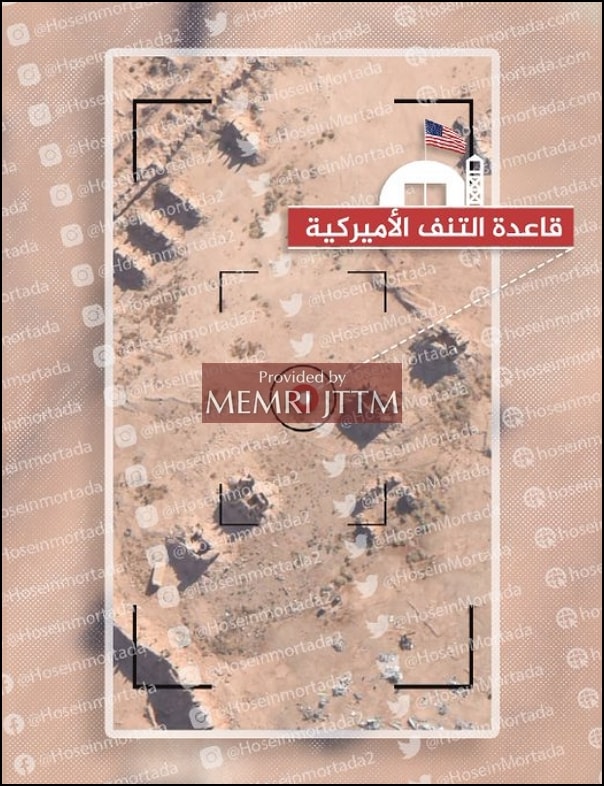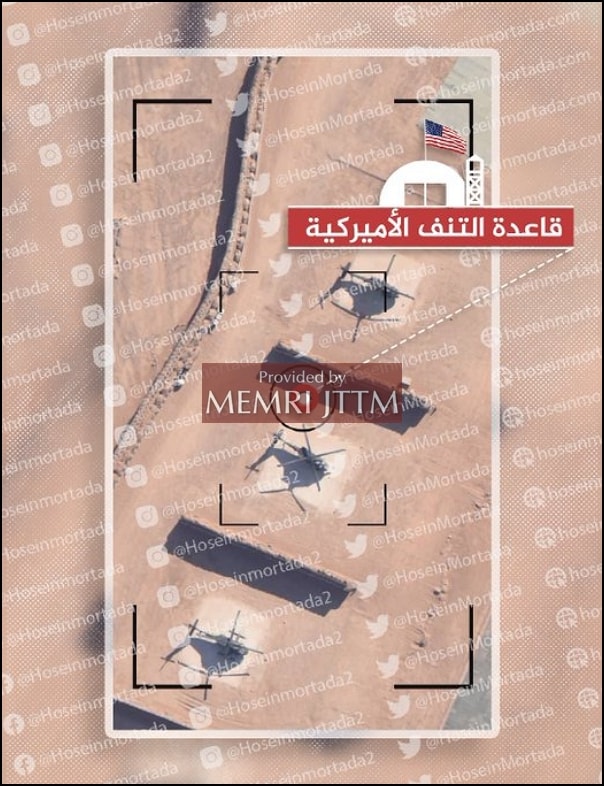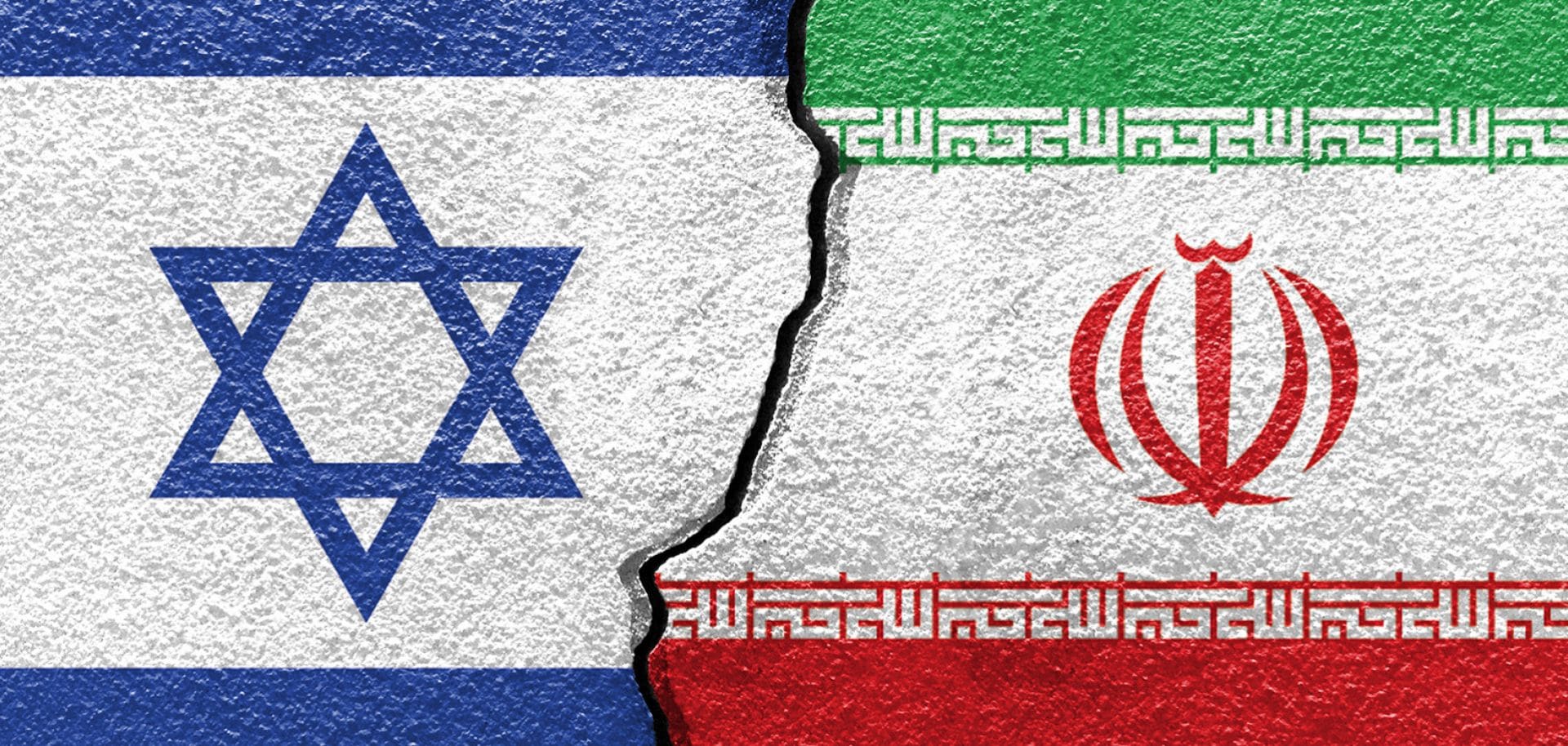The following report is now a complimentary offering from MEMRI's Jihad and Terrorism Threat Monitor (JTTM). For JTTM subscription information, click here.
On July 13, 2022, Hussein Mortada, a Lebanese journalist who is identified with Hizbullah, shared "exclusive" aerial photographs on Facebook and Twitter[1] of the U.S. Al-Tanf military base, which is located inside territory controlled by the Syrian opposition in Homs Governorate, in southern Syria, writing: "At a time when there is talk of an 'Arab NATO' whose main base is the American Al-Tanf base in Syria, adjacent to the border between Jordan and Iraq, we are publishing exclusive photographs of this base and its contents." Mortada also writes, "This is a clear message that all targets are in the range of the rockets and the drones. The photographs are high-quality, the drones returned [safely to base] and there are more…"





In an article written by Mortada that appeared in a July 15, 2022 article titled, "American Occupation Base in Al-Tanf – New Clause in the Target Bank,"[2] in the Lebanese Al-Binaa newspaper, he expanded on his social media posts, adding, "It seems that this is a drone war on more than one front and in more than one geographical area. A new strategic site is in the range of the lenses and in the firing range of the drones – Al-Tanf base, the most important American base in the border area between Syria, Iraq, and Jordan."

Lebanese journalist Hussein Mortada (Source: Al-binaa.com, July 15, 2022).
According to Mortada, "Recently the axis of resistance was able to photograph the base from the air, with drones, and to acquire information of a security nature about the base, while the aerial defense measures of the American occupation didn't intercept those drones… The accurate photographs show the location of the forces, a training base, a helicopter pad and most important of all – communications devices and surveillance equipment which were set up at the base." Mortada further states that the base also supplies intelligence data to "the Israeli occupation entity," and hosts "visits from generals of the American occupation [forces] who meet there with the commanders of several terrorist cells who cooperate with them, even at the current time, in southern Syria."
Mortada claims that, "The American occupation forces bring Islamic State (ISIS) terrorists to this base from Syrian Democratic Forces (SDF) prisons and from the Rukban refugee camp [in southeast Syria, on the border with Jordan] in order to train them and dispatch them on various missions in Iraq and in the Syrian desert region." He writes that the base has been attacked in the past, several times, and that the "occupation forces" stationed there suffered losses.
It should be noted that on June 27, 2022, the Syrian Thiqa-news opposition website reported that, "Hizbullah intends to perpetrate attacks on areas controlled by the Global Coalition [to Defeat ISIS] in the 55-kilometer area surrounding the Al-Tanf base, employing drones which it received hours ago [at its base at the] T-2 [oilfield] in southeastern Homs."[3]
Mortada's reports corroborate the noticeable increase in the past year in the use of drones by the Iran-backed militias in Iraq, Yemen, Lebanon, and Syria.[4]
[1] Twitter.com, July 13, 2022; and Facebook.com, July 13, 2022.
[2] Al-binaa.com, July 15, 2022.
[3] See MEMRI JTTM Report: Syrian Opposition Website: Hizbullah Intends To Launch Drone Attack On Al-Tanf Area Where U.S. Forces Are Stationed, June 28, 2022.
[4] See MEMRI JTTM Reports: Iran-Backed Iraqi Group Claims Drone Attack On Turkish Base In Iraq, May 22, 2022; Iran-Backed Militias Report Drone Attack On 'Ayn Al-Assad Base, Iraq; Publish Photo Of Alleged Attack On U.S. Forces In Syria, April 8, 2022; Houthis Claim Responsibility For Attack On Civilian Facilities in UAE, Warn Citizens And Foreigners: UAE Is No Longer Safe Country, January 17, 2022; and PMU Unveils Drones As Their Use Increases Within The Iranian-Led Axis Of Resistance, June 14, 2021.
The full text of this post is available to subscribers.
Please login or register to request subscription information from MEMRI




